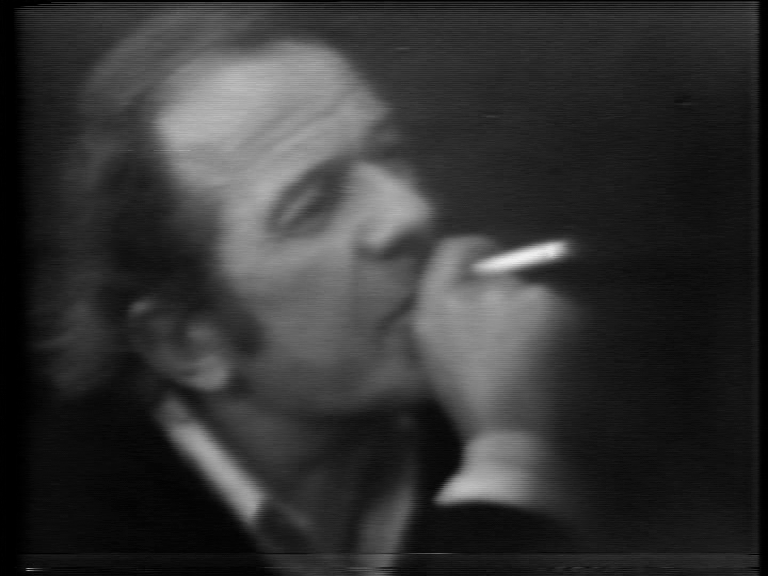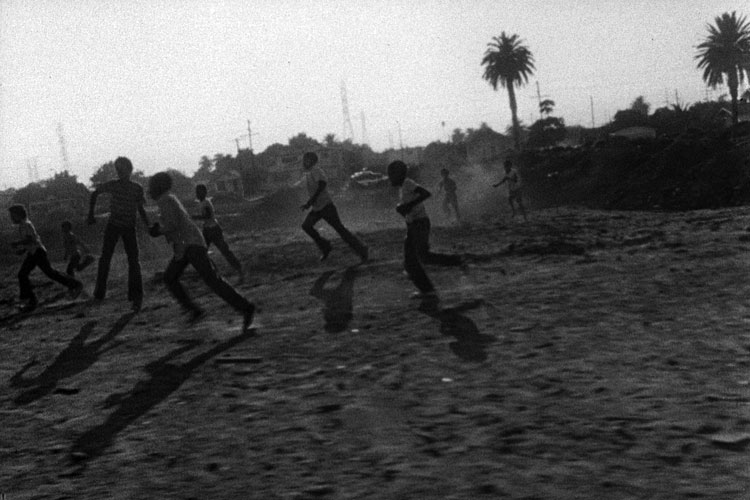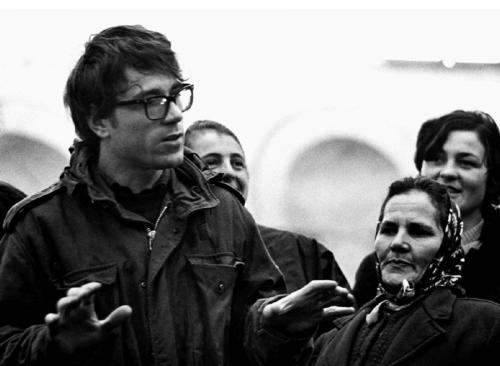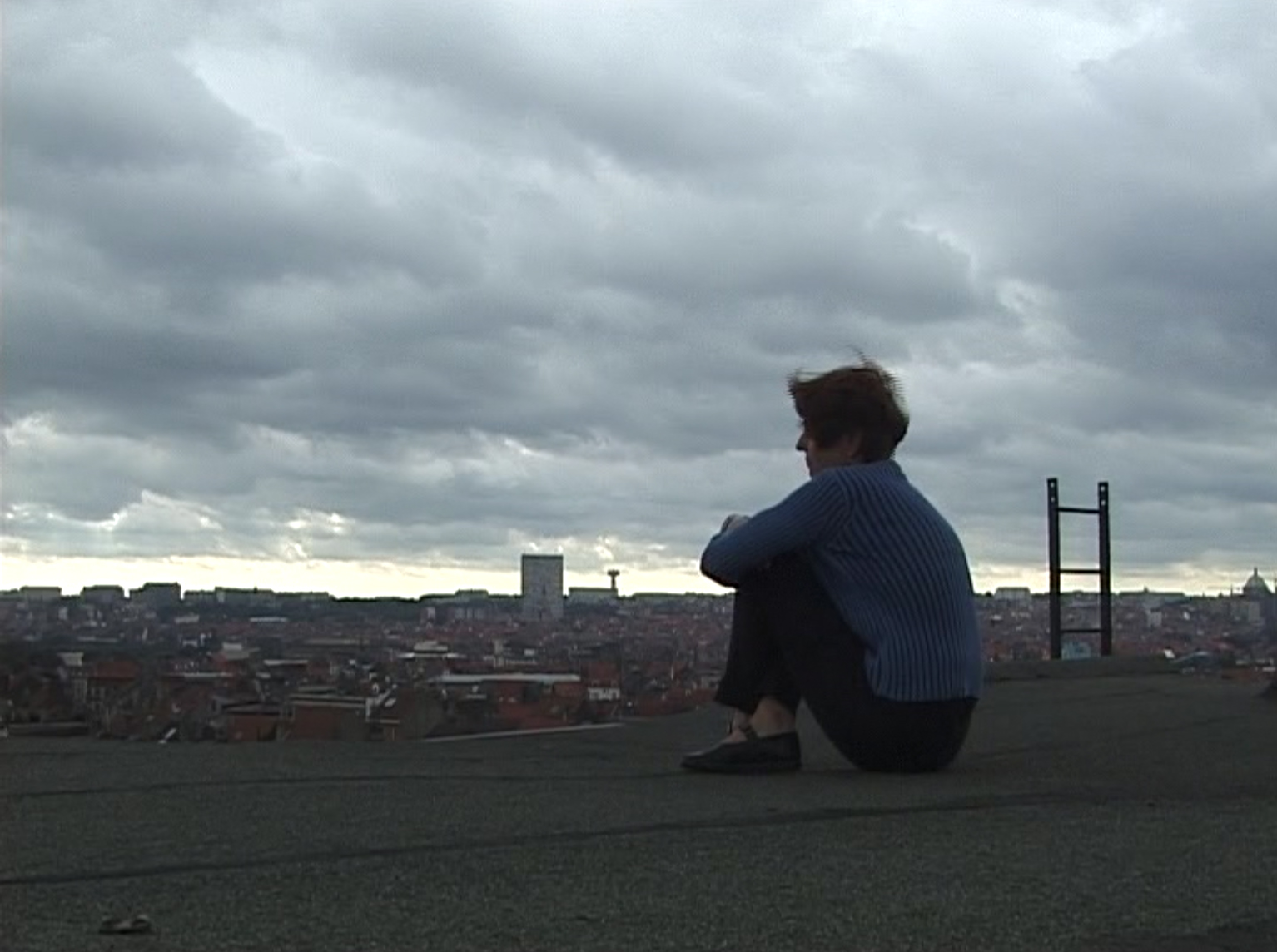
Interview with Gilles Deleuze
Originally published as ‘Le cerveau, c’est l’écran’ in Cahiers du cinéma 380, February 1986, the result of a roundtable with Alain Bergala, Pascal Bonitzer, Marc Chevrie, Jean Narboni, Charles Tesson and Serge Toubiana on the occasion of the publication of Deleuze’s ‘Time-Image’ (Minuit, 1985). Translated by Marie Therese Guirgis.
One often hears it said, here and there, like the echo of a pessimistic leitmotif, that there will be no more theoretical advancements in cinema. The publication of the second volume by Gilles Deleuze, The Time-Image, is very much proof to the contrary. If the cinema, by means of genre, by narrative flow, or through the writing styles of singular auteurs, is the manifestation of a thought in motion, its encounter with philosophy was therefore inevitable. The important work accomplished by Gilles Deleuze shows that the relationship between thought and cinematographic art is rich in interactive shocks, vibrations, and influences—whether underground or visible—because a common necessity is at stake: the necessity to recount life itself. This second work, like the first, proves extraordinarily fertile for those who love the cinema and who attempt to reflect on and to ponder its history, its fractures, or its auteurs. Besides the specifically philosophical work, which consists of producing concepts that explain movement, this book also reveals Deleuze as a critic who delineates each auteur’s place, his proper aesthetic configuration relative to key concepts: light, space, time, and signs. This interview is the fruit of a long conversation between Cahiers du cinema and Gilles Deleuze, one that was rearranged by him in more of a synthesis and therefore rendered more dense.
FROM PHILOSOPHY TO CINEMA
How did the cinema enter your life, both as a spectator and, of course, as a philosopher? When did you begin to love cinema and when did you begin to consider it a domain worthy of philosophy?
I had a privileged experience because I enjoyed two separate phases of filmgoing. Before the war, as a child, I went to the cinema rather often: I think that there was a familial structure to the cinema because of subscription theaters like the Salle Pleyel. You could send children there by themselves. I didn’t have the choice of program, sometimes it was Harold Lloyd or Buster Keaton, sometimes Les Croix de bois (The Wooden Crosses)—which upset me; they even showed Fantomas, again, which made me very scared. It would be interesting to find out which theaters disappeared after the war in a given neighborhood. New theaters sprang up, but many disappeared. And then, after the war, I returned to the cinema, but in another manner. I was a student of philosophy, and although I wasn’t stupid enough to want to create a philosophy of cinema, one conjunction made an impression on me. I liked those authors who demanded that we introduce movement to thought, “real” movement (they denounced the Hegelian dialectic as abstract movement). How could I not discover the cinema, which introduces “real” movement into the image? I wasn’t trying to apply philosophy to cinema, but I went straight from philosophy to cinema. The reverse was also true, one went right from cinema to philosophy. Something bizarre about the cinema struck me: its unexpected ability to show not only behavior, but spiritual life [la vie spirituelle] as well (at the same time as aberrant behavior). Spiritual life isn’t dream or fantasy—which were always the cinema’s dead ends—but rather the domain of cold decision, of absolute obstinacy, of the choice of existence. How is it that the cinema is so expert at excavating this spiritual life? This can lead to the worst, a cinematic Catholicism or religious kitsch [sulpicisme] specific to the cinema, but also to the greatest: Dreyer, Sternberg, Bresson, Rosselini, and even Rohmer today. It’s interesting how Rohmer assigns to cinema the study of the spheres of existence: aesthetic existence in La Collectionneuse, ethical existence in Le Beau mariage, religious existence in Ma nuit chez Maud. One thinks of Kierkegaard, who, well before cinema, already felt the need to write in odd synopses. Cinema not only puts movement in the image, it also puts movement in the mind. Spiritual life is the movement of the mind. One naturally goes from philosophy to cinema, but also from cinema to philosophy.
The brain is unity. The brain is the screen. I don’t believe that linguistics and psychoanalysis offer a great deal to the cinema. On the contrary, the biology of the brain—molecular biology—does. Thought is molecular. Molecular speeds make up the slow beings that we are. As Michaux said, “Man is a slow being, who is only made possible thanks to fantastic speeds.” The circuits and linkages of the brain don’t preexist the stimuli, corpuscles, and particles [grains] that trace them. Cinema isn’t theater; rather, it makes bodies out of grains. The linkages are often paradoxical and on all sides overflow simple associations of images. Cinema, precisely because it puts the image in motion, or rather endows the image with self-motion [automouvement], never stops tracing the circuits of the brain. This characteristic can be manifested either positively or negatively. The screen, that is to say ourselves, can be the deficient brain of an idiot as easily as a creative brain. Look at music videos: their power was in their novel speed, their new linkages and relinkages. Even before developing their strength, however, music videos had already collapsed in pitiful twitches and grimaces, as well as haphazard cuts. Bad cinema always travels through circuits created by the lower brain: violence and sexuality in what is represented—a mix of gratuitous cruelty and organized ineptitude. Real cinema achieves another violence, another sexuality, molecular rather than localized. The characters in Losey, for example, are like capsules [des comprimes] composed of static violence, all the more violent because they don’t move. These stories of the speed of thought, precipitations or petrifications, are inseparable from the movement-image. Look at speed in Lubitsch, how he puts actual reasoning into the image, lights—the life of the spirit.
The encounter between two disciplines doesn’t take place when one begins to reflect on the other, but when one discipline realizes that it has to resolve, for itself and by its own means, a problem similar to one confronted by the other. One can imagine that similar problems confront the sciences, painting, music, philosophy, literature, and cinema at different moments, on different occasions, and under different circumstances. The same tremors occur on totally different terrains. The only true criticism is comparative (and bad film criticism closes in on the cinema like its own ghetto) because any work in a field is itself imbricated within other fields. Godard confronts painting in Passion and music in Prenom Carmen, making a “serial cinema,” but also a cinema of catastrophe, in the sense corresponding to the mathematical principle of René Thorn. There is no work that doesn’t have its beginning or end in other art forms. I was able to write about cinema, not because of some right of consideration, but because philosophical problems compelled me to look for answers in the cinema, even at the risk that those answers would suggest other problems. All work is inserted in a system of relays.
A PASSION FOR CLASSIFICATION
What strikes us in your two books on cinema is something that one already finds in your other books, but never to this extent, namely, taxonomy—the love of classification. Have you always had this tendency, or did it develop over time? Does classification have a particular connection to cinema?
Yes, there’s nothing more fun than classifications or tables. They’re like the outline of a book, or its vocabulary, its glossary. It’s not the essential thing, which comes next, but it’s an indispensable work of preparation. Nothing is more beautiful than the classifications of natural history. The work of Balzac is based on astonishing classifications. Borges suggested a Chinese classification of animals that thrilled Foucault: belonging to the emperor, embalmed, domesticated, edible [cochons de hit], mermaids, and so on. All classifications belong to this style; they are mobile, modifiable, retroactive, boundless, and their criteria vary from instance to instance. Some instances are full, others empty. A classification always involves bringing together things with very different appearances and separating those that are very similar. That is the beginning of the formation of concepts. We sometimes say that “classic,” “romantic,” or “nouveau roman”—even “neorealism”—are insufficient abstractions. I believe that they are in fact valid categories, provided that we trace them to singular symptoms or signs rather than general forms. A classification is always a symptomology. What we classify are signs in order to formulate a concept that presents itself as an event rather than an abstract essence. In this respect, the different disciplines are really signaletic materials [des matieres signaletiques]. Classifications will vary in relation to the materials considered, but they will also coincide according to the variable affinities among materials. Cinema is at the same time a very uncommon material, because it moves and temporalizes the image, and one that possesses a great affinity with other materials: pictorial, musical, literary…. We must understand cinema not as language, but as signaletic material.
For example, I’m attempting a classification of light in the cinema. There is light as an impassive physical milieu whose composition creates white, a kind of Newtonian light that you find in American cinema and maybe in another way in Antonioni. Then there is the light of Goethe [la lumiere goetheenne], which acts as an indivisible force that clashes with shadows and draws things out of it (one thinks of expressionism, but don’t Ford and Welles belong to this tradition as well?). Yet another light stands out for its encounter with white, rather than with shadows, this time a white of principal opacity (that’s another quality of Goethe that occurs in the films of von Sternberg). There is also a light that doesn’t stand out for its composition or its kind of encounter but because of its alternation, by its production of lunar figures (this is the light of the prewar French school, notably Epstein and Gremillon, perhaps Rivette today; it’s close to the concepts and practices of Delauney). The list shouldn’t stop here because it’s always possible to create new events of light; we see this, for example, in Godard’s Passion. In the same way, one can create an open classification of cinematic space. One can distinguish organic or encompassing spaces (in the western, but also in Kurosawa, who adds immense amplitude to the encompassing space); functional lines of the universe (the neowestern, but Mizoguchi above all); the flat spaces of Losey—banks, bluffs, plateaus that allowed him to discover Japanese space in his last two films; disconnected spaces with undetermined junctions, in the style of Bresson; empty spaces, as in Ozu or Antonioni; stratigraphic spaces that are defined by what they cover up, to the point that we “read” the space, as in the Straubs’ work; the topological spaces of Resnais … and so on. There are as many spaces as there are inventors. Light and spaces combine in very different ways. In all these instances, one sees that these classifications of light or space belong to the cinema yet nonetheless refer to other domains, such as science or art, Newton or Delauney—domains that will take them in another order, in other contexts and relations, and in other divisions.
THE NAME OF THE AUTHOR
There is a “crisis” regarding the concept of the cinematic auteur. Current discourse about the cinema might go as follows: “There are no more auteurs, everyone is an auteur, and all of them get on our nerves.”
Right now many forces are trying to deny any distinction between the commercial and the creative. The more that we deny this distinction, the more we consider ourselves clever, understanding, and “in the know.” In fact, we are only betraying one of the demands of capitalism: rapid turnover. When advertisers explain that advertisements are the poetry of the modern world, they shamelessly forget that no real art tries to create or exhibit a product in order to correspond to the public’s expectations. Advertising can shock or try to shock because it responds to an alleged expectation. The opposite of this is art produced from the unexpected, the unrecognized, the unrecognizable. There is no commercial art: that’s nonsense. There are popular arts, of course. There are also art forms that require some amount of financial investment; there is a commerce of art, but no commercial art. What complicates everything is that the same form serves the creative and the commercial. We already see this in book publishing: the same material format is used for both Harlequins and Tolstoy. If you compare a great novel and a best-seller, the bestseller will always win in a market of quick turnover, or worse, the best-seller will aspire to the qualities of the great novel, holding it hostage. This is what happens in television, where aesthetic judgment becomes “that’s tasty,” like a snack, or “that’s too bad,” like a penalty in soccer. It’s a promotion from the bottom, an alignment of all literature with mass consumption. “Auteur” is a function that refers to artwork (and under other circumstances, to crime). There are other just as respectable names for other types of producers, such as editor, programmer, director, producer … Those who say that “there are no more auteurs today” suggest that they would have been able to recognize those of yesterday, at a time when they were still unknown. That’s very arrogant. No art can thrive without the existence of a double sector, without the still relevant distinction between commercial and creative.
Cahiers did a great deal to establish this distinction in the cinema itself and to show what it means to be an auteur of films (even if the field also consists of producers, editors, publicity agents, etc.). Paini recently said some interesting things about all this. Today, people think they are clever by denying the distinction between the commercial and the creative: that’s because they have an interest in doing so. Every [truly creative piece of] work, even a short one, implies a significant undertaking or a long internal duration [une longue duree interne] (it’s no great undertaking, for instance, to recount recollections of one’s family). A work of art always entails the creation of new spaces and times (it’s not a question of recounting a story in a well-determined space and time; rather, it is the rhythms, the lighting, and the space-times themselves that must become the true characters).
A work should bring forth the problems and questions that concern us rather than provide answers. A work of art is a new syntax, one that is much more important than vocabulary and that excavates a foreign language in language. Syntax in cinema amounts to the linkages and relinkages of images, but also the relation between sound and the visual image. If one had to define culture, one could say that it doesn’t consist in conquering a difficult or abstract discipline, but in perceiving that works of art are much more concrete, moving, and funny than commercial products. In creative works there is a multiplication of emotion, a liberation of emotion, and even the invention of new emotions. This distinguishes creative works from the prefabricated emotions of commerce. You see this, oddly, in Bresson and Dreyer, who are masters of a new kind of comedy. Of course, the question of auteur cinema assures the distribution of existing films, films that can’t compete with the commercial cinema, because they require another kind of duration. But auteurism also makes the creation of new films possible. In this sense, maybe cinema isn’t capitalist enough. There are financial circuits of very different lengths; the long term, the medium term, and the short term have to be distinguishable in cinematographic investment. In science, capitalism has been able to acknowledge the importance of fundamental research now and then.
THIS IS NOT THE PRESENT
Your book contains a thesis that appears “scandalous,” that opposes everything written about cinema and that precisely concerns the time-image. Cinematic analysis has always argued that in a film, despite the presence of flashbacks, dreams, memories, or even anticipatory scenes, no matter what time is evoked, movement is enacted before you in the present. But you assert that the cinematic image isn’t in the present.
That’s funny, because it seems obvious to me that the image is not in the present. What the image “represents” is in the present, but not the image itself. The image itself is an ensemble of time relations from the present which merely flows, either as a common multiple, or as the smallest divisor. Relations of time are never seen in ordinary perception, but they are seen in the image, as long as it is a creative one. The image renders time relations —relations that can’t be reduced to the present—sensible and visible. For example, an image shows a man walking along a riverbank in a mountain region; in this image there are at least three coexistent “durations,” three rhythms. The relation of time is the coexistence of durations in the image, which has nothing to do with the present, that is, what the image represents. In this sense, Tarkovsky challenges the distinction between edit and shot, because he defines cinema by the “pressure of time” in the shot. It’s obvious if we consider examples: a still life in Ozu, a traveling shot in Visconti, and depth of field in Welles. On the level of the represented, it’s an immobile bicycle, a car, or a man traveling in space. But from the point of view of the image, Ozu’s still life is the form of time that doesn’t change, even though everything changes within it (the relation of that which is in time with time). In the same way, Sandra’s car in Visconti’s film (Sandra) is embedded in the past, and we see it at the same time as she travels through space in the present. It has nothing to do with a flashback or with memory, because memory is only that which was once present, whereas the character in the image is literally embedded in the past, or emerges from the past. As a general rule, once a space ceases to be “Euclidean,” once space is created—as in Ozu, Antonioni, and Bresson—space no longer contains those characteristics associated with previously accepted relations of time. Resnais is certainly one of the auteurs for whom the image is least in the present, because the image in Resnais’s films depends entirely on the coexistence of heterogeneous durations. The variation of relations of time is the very subject of Je t’aime, je t’aime, independent of any flashbacks. What is false continuity, or the disjunction between speaking and seeing in the films of the Straubs or Marguerite Duras, or even the feathery [plumeux] screen of Resnais, or the black or white cuts of Garrell? On each occasion, it’s “a little time in its pure state,” and not in the present. The cinema doesn’t reproduce bodies, it produces them with grains that are the grains of time. When it is said that cinema is dead, it’s especially stupid, because the cinema is at the very beginning of an exploration of audiovisual relations, which are relations of time and which completely renew its relationship with music. Television remains inferior because it clings to images in the present. Television renders everything in the present, except when it is directed by great cineasts. The concept of the image in the present only applies to mediocre or commercial images. It’s a completely ready-made and false concept, a kind of fake evidence. To my knowledge, only Robbe-Grillet revitalizes it. But he does so precisely with diabolical malice. That is because he is one of the only auteurs to effectively produce images in the present, but thanks to very complex relations of time unique to him. He is the living proof that such images are difficult to create if one isn’t content with that which is represented. The present is not at all a natural given of the image.



